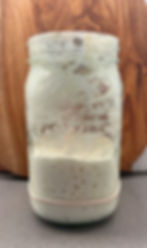
Explore our recipes.

Creating your own sourdough starter is a rewarding journey into the world of baking. This simple recipe requires just two ingredients and some patience, but the results are well worth it. With a thriving starter, you can bake delicious homemade sourdough bread and use the discard in various creative recipes!

What is Sourdough Starter?
Sourdough starter is a living culture of flour and water that harnesses wild yeast and beneficial bacteria from the environment to ferment dough. Unlike commercial yeast, which provides a quick rise, sourdough starter develops over time, creating complex flavors and a distinct tang.
The natural fermentation process not only enhances the taste of baked goods but also improves their digestibility. This is because the beneficial bacteria break down gluten and phytic acid, making nutrients more accessible and easier for our bodies to absorb.
Additionally, sourdough is often considered gut-friendly due to its probiotic content, which can promote a healthy gut microbiome. Whether used in bread, pancakes, or pizza, sourdough starter embodies the art of traditional baking and the beauty of fermentation.
Prep Time: 10 minutes
Total Time: 2~4 weeks (to establish)
Ingredients:
100g unbleached all-purpose flour (or whole wheat flour)
200g water (preferably warm)
Rubber band (for measuring growth)
Equipment:
A large glass jar
Kitchen scale
Loose lid or plastic wrap
Spatula or spoon for mixing
Instructions:
Day 1: In a glass jar, weigh out 100g of unbleached flour and mix with 100g of warm water until no dry flour remains. Loosely cover it (allowing air to still come in), and let it sit at room temperature, on your counter, for 24 hours. Place the rubber band around the jar and align it with the height of your flour/water mixture.
Days 2-14: Each day, discard/remove half of the starter into the trash and feed it with 100g of unbleached flour and 100g of filtered water. Stir well, cover loosely, and let it sit. By around Day 5-10, you should see bubbles and growth, indicating your starter is active. Once active, you can now start saving your discard. Pour the discard into a separate container, with a screw on lid, and place it into the fridge to use for other recipes.
Testing Readiness: Your starter is ready when it consistently doubles in size within 4-6 hours of feeding and passes the float test—scoop a spoonful into water; if it floats, it’s ready to use!
Notes:
1:1:1 ratio means equal parts starter, flour and water (i.e. 50g starter, 50g flour, 50g water.)
Before baking anything, you should always feed a 1:2:2 ratio (i.e. 50g starter, 100g flour, 100g water). This is to ensure that you have enough starter for your recipe, while also leaving some in your jar so that you can feed and use it again for more recipes.
You can even do a 1:3:3 ratio (50g starter, 150g flour, 150g water, but note, it will take longer to double in size. I typically do this the night before around 8pm and use my starter the following morning).
Additional Tips:
Choosing Your Flour: Whole wheat flour is ideal for the initial stages, while all-purpose flour can also be used, just make sure it is unbleached flour (King Arthur's is my favorite).
Water Quality: Use tap, filtered, or bottled water. Avoid distilled water as it lacks necessary minerals. You can also use warm filtered water for quicker rising, or if your starter is struggling. Be careful and make sure it is not too warm or it could kill the starter.
Environment Matters: If your kitchen is too warm or cool, adjust the temperature where you store the starter to promote healthy growth. Ideal temperature is between 70-80°F.
Storing Instructions:
Room Temperature: Keep feeding daily if you store your starter at room temperature. You can even feed your starter twice a day (once in the morning and once at night).
Refrigerator: Once your starter is established (meaning it doubles/triples in size within 4~6 hours of feeding) you can then place it in the fridge for less frequent feedings (i.e. going out of town, or you just don't need to use it every single day). Just make sure you feed it before placing it into the fridge and screw a lid on tightly to prevent mold growth at cold temperatures. Once you are ready to bake with your starter, remove it from the fridge, take the lid off, and feed two times before using.
Long-term Storage: You can freeze or dehydrate your starter for long-term storage.
Using Sourdough Discard:
Once your starter is established (around a week), you can use the discard in various recipes like pancakes, muffins, or pizza dough. Just remember to store the discard in an airtight container in the fridge and use it within 2-4 weeks.
Common Challenges:
Overflowing Jar: Ensure your jar is large enough to allow the starter to grow.
Airflow Issues: Use a loose cover to allow air circulation; a tight lid will suffocate your starter.
Temperature Control: Keep your starter in a stable environment (ideally around 70-80°F).
With these tips and steps, you’ll be on your way to cultivating a robust sourdough starter that enhances your baking adventures!




